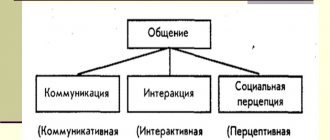Every person who develops in social life has interaction with other people, as well as communication goals that guide him when conducting dialogue. A person is connected with nature by his biological beginning, therefore his primary needs are considered to be safety, the availability of food, water, and a roof over his head. After an individual provides himself with these vital elements, an important aspect becomes mutual understanding, feelings of love, warmth, and approval from others.
Communication concept
Not a single person in his life can avoid interaction with other members of society, since it is difficult to achieve any heights or improvement alone.
Articles on the topic
- What to do if a work colleague is annoying: how to avoid confrontation 12/06/2020
- How to ignore someone who annoys you and stay calm 12/06/2020
- Primitive communication: how not to succumb to the pressure of a boor 11/14/2020
- An important step to success in life is effective communication 11/14/2020
From infancy, a child learns to communicate by looking at his parents and gains skills through role-playing games, reading, drawing, modeling and other educational materials. His ability to freely enter a circle of people directly depends on how much he was taught this in childhood.
Communication in psychology is understood as a complex process, as a result of which people exchange information, receive and share emotions, perceive each other and draw conclusions about actions and behavior.
On its basis, relationships are formed or broken, contacts are established.
Features of conversation in different situations: what to consider
Since the main functions of conversation in psychology are considered to be establishing interpersonal contact and obtaining information, for a full conversation it is necessary to take into account the situation and form of communication. Main types of communication:
- Primitive - the selection of interlocutors occurs for selfish purposes, for personal reasons.
- Manipulative - used for gain. Means of manipulation are selected individually.
- Spiritual - close contact between people who know each other well and have established a high degree of trust.
- Formal-role communication occurs not with a person, but with his social image.
- Business - the interest of the business is placed above individual characteristics, but they are also taken into account.
- Secular - exchange of remarks that are acceptable for a specific situation. The real opinion of the interlocutors does not matter.
- “Contact of masks” is the exchange of information of a formal nature, concealment of true views in order to distance oneself and comply with the rules accepted in society.
In everyday communication, people use several types of verbal interaction. The form of information exchange must be appropriate to the situation and time. Knowing how to communicate the right way is an important skill for establishing long-lasting relationships.
Communication goals
Interaction between people is never aimless. In any case, it is based on the motives that each of the interlocutors pursues personally for himself.
By delving into a conversation, one person can carry on a conversation with an opponent, guided by his own motive. The other will at the same time have his own interest, for the sake of which he devoted time to this conversation.
The goals of communication are:
- desire to meet or establish relationships;
- provide help or ask for it from the interlocutor;
- find a partner for further interaction or conduct of activities, as well as receive sympathy and an emotional response;
- the opportunity to self-actualize or establish yourself, express your feelings, show skills;
- to introduce another person to beliefs, opinions, educate, train;
- change personal intentions, views on familiar events.
An individual chooses a partner for communication based on similar interests in hobbies and activities, proximity to certain moral qualities, physical characteristics, appearance, and level of intelligence.
What motives a person pursues depends on character, temperament, family upbringing, age, and life experience.
How to tune in to the same wavelength as your interlocutors?
The general mood in the company of interlocutors is formed due to a chain reaction - the mood is transferred from one person to another. In order to get within the given framework of the discussion and not accidentally create a conflict situation within the group of interlocutors, it is important not to join the conversation right away. First, you should familiarize yourself with the topic and assess the attitude of the participants to the subject of conversation. You can't change the subject, or at least try to do it abruptly. It is important to monitor the interaction of your interlocutors and take into account their emotional reactions.
Levels of communication depend on the purpose of communication
A person who, after communicating with other people, conducts introspection, often asks the question - why is this interlocutor contacting me? Do I need his attention? They are quite logical, since dialogue often occurs under the influence of negative motivation. It benefits only one of the talking persons.
Levels of interaction have been formed depending on the goals of communication:
- At a primitive level. When one person or both do not perceive the other as a person.
- Manipulation. Need due to the desire to use for something. Trying to suppress, influence feelings, looking for a weak point.
- Under the mask. Hiding your true feelings and desires when social norms require participation, but people are not interested.
- Convention level. The interlocutors are on an equal footing and do not stoop to manipulation in order to appear in a favorable light. We are ready to discuss solutions to benefit each of them.
- Game level. Communication is based on sympathy, there is an emotional connection.
- Business level. The interlocutors take each other seriously and are ready to help in difficult times.
- Spiritual unity. Those communicating are open and do not hide their true intentions. They are ready to express their point of view and accept the opinion of another person with dignity, even if it does not suit them.
Communication in society occurs in different positions. Each individual has representatives among those around him with whom he communicates using these levels.
What does understanding mean during communication, and how to achieve it?
Due to the subjectivity of views during a conversation, misunderstandings may arise. The views of individuals are of a subjective nature - people can understand different things under the same terms, but believe that the interlocutor shares their opinion. Misunderstandings cause conflicts. Most often it arises due to differences in age, level of education, and religious views.
To avoid misinterpretation, interlocutors should clarify controversial points. When discussing potentially conflicting topics, it is important not only to express your point of view, but also to take into account the opinion of your interlocutor. Conversation is a means that should be used consciously.
Why is a person afraid of communication: reasons and ways to combat phobia?
Fear of communication often occurs in early childhood. At the first unsuccessful attempt to talk with peers, the child becomes withdrawn and avoids contact. Pressure from adults only increases his discomfort, causing him to become self-absorbed and afraid of people. If a person does not cope with the problem of social anxiety in adulthood, he is deprived of the opportunity to create normal work and friendships.
The situation can be corrected with targeted long-term therapy. Fear of talking can be treated by gradually engaging in social interaction. At first, a person learns to have short-term conversations with strangers, gradually complicating the forms of interaction to multi-level close contact.
Useful video
Unlimited Knowledge
Researchers have concluded that in many cases the main purpose of communication is to gain experience.
The knowledge of each individual person is quite limited, so often we cannot even imagine the full picture of what is happening. The process of communication opens the door to a treasury of world experience. Reading books, searching for information on the Internet, and live communication with experienced professionals are all valuable sources of information.
In addition, as we know, truth is born in a dispute: many new ideas and ideas are the result of productive communication.
Those who know how to listen to their opponents are much more far-sighted than those who fiercely try to defend their point of view.
By listening to the opinions of another person, you get the opportunity to look at what is happening from the outside and draw the right conclusions.
Problems arise when communicating: how to identify and avoid them
The main problem of interpersonal communication arises when interlocutors pursue different goals. For one of them, interaction is a means of obtaining benefits, for the other it is a search for emotional intimacy. The inability or unwillingness to correctly identify the purpose of the conversation causes misunderstanding. The greater the difference in the views of the interlocutors, the higher the chances of an unproductive conversation that causes a negative reaction from all participants.
Psychologists believe that to avoid problems in communication, the mutual desire of the interlocutors is sufficient. A friendly attitude and attention can smooth out the initial awkwardness.
The purpose and objectives of speech communication
Practical lesson No. 1 (2 hours)
Speech communication as a process. Basic Concepts
Communication is a necessary condition for human life and one of the fundamental foundations of the existence of society. Society is not so much a collection of individuals as the connections and relationships in which these individuals are with each other. In other words, communication is a specific exchange of information, the process of transmitting emotional and intellectual content. Experts distinguish several basic meanings of the concept of “communication”:
— universal (extremely broad), in which communication is considered as a way of connecting any objects of the material and spiritual world;
- technical, corresponding to the idea of communication as a route of communication, the connection of one place to another, a means of transmitting information and other material and ideal objects from one place to another;
- biological, widely used in biology, especially in the section of ethology, in studies of signal communication methods in animals, birds, insects, etc.;
- social, used to designate and characterize the diverse connections and relationships that arise in human society.
Speech communication is communication between people, understood in the broad sense of the word not only as a conversation, conversation, but as any interaction for the purpose of exchanging information (reading, writing, etc.). The specificity of the interaction of people in the process of their life is the use of language. Language, being the most important means of human communication, also acts as an instrument of cognition, as an instrument of thinking. The main goal of speech communication is the exchange of information of various kinds. Communication and exchange of information between people is carried out not only through language. Since ancient times, human society has used additional means of communication and information transfer, many of which still exist. Road signs, traffic signals, flag signaling, etc. - all these are means of transmitting information that complement the main means of human communication - language.
Thus, verbal and nonverbal forms of communication are distinguished. Verbal communication is communication using words, nonverbal is the transfer of information using various non-verbal symbols and signs (looks, facial expressions, gestures, movements, posture).
The purpose and objectives of speech communication
The main purpose of verbal communication is the exchange of information.
Tasks of speech communication:
· effectively obtaining information (depending on the level of reading and listening skills);
· effective transmission of information (possession of writing and speaking skills);
· achieving the set goal by persuading the interlocutor and encouraging him to act (knowledge of basic rhetorical techniques);
· obtaining additional information about the interlocutor (knowledge of the objective laws of the functioning of language in society, the ability to distinguish shades of intonation and voice of the interlocutor, the ability to interpret the content of his statements and understand possible subtext);
· positive self-presentation (the ability to make a good impression on the interlocutor presupposes mastery of the basics of speech culture).
Forms of communication : oral and written. Spoken and written language share many features, as can be seen from the following table:
| Opposition parameters | Oral speech | Written speech |
| 1. Language signs | Flow of sounds, pauses, intonation, stress | "Flow" of letters, punctuation marks |
| 2. Non-linguistic signs | Gestures, facial expressions, postures, etiquette behavior | No |
| 3. Execution | It unfolds dynamically in time, is linear, irreversible, and does not allow the text to be altered | Static, presented on paper, allows pauses for choosing words, adjusting, reworking the text |
| 4. Addressee | Specific listener/listeners | Abstract reader and concrete addressee |
| 5. Style | Colloquial | Book and literary |
| 6. Other characteristics | Situationally determined, spontaneous, based on dialogue /monologue/ | Does not depend on the situation, prepared, based on a monologue |
Oral speech is primary in relation to written speech: it arose as the first instrument of human society, and only much later did the first written signs appear to record it. As a rule, two spheres of human activity in which oral speech is used are distinguished - social and personal (everyday). The main differences can be presented in the following table:
| Characteristic signs of differentiation | Public sphere | Everyday life sphere |
| 1.Nature of communication | official | informal |
| 2. Preconditions for communication | preparedness | lack of preparation |
| 3. Content factor | thematic assignment | thematic freedom |
| 4. Initiatives | socially determined | private |
| 5. Speech style | literary | colloquial |
| 6.Quantitative parameter of communication | collective or mass communication | limited number of participants |
| 7. Etiquette standards | are strictly observed | freedom of choice |
| 8. Type of speech | monologue/dialogue | dialogue |
In the sphere of public activity, oral public /rhetorical/ speech is widespread. It is a synthesis of spoken and written speech. The more widely live colloquial speech is represented in a public speech, the higher its effective power. On the other hand, accuracy, logic, argumentation, and aesthetic finishing of the oratorical word are based on the foundation of written speech. From “colloquiality” comes intonation, imagery, direct contact with listeners, improvisation and impromptu, and from it comes the rhetorical organization of the text. From written speech - literary, aesthetic, and in certain cases - artistic.
Types of speech communication are determined by a number of characteristics.
1. According to the terms of communication: a) direct, or immediate, communication with active feedback (dialogue) and passive feedback (written order); b) indirect communication (speech on television, in the media).
2. By the number of participants: a) monologue (speech of one person); b) dialogue (speech between two people); c) polylogue (speech of several people).
3. According to the purpose of communication: a) information; b) belief ; c) entertainment.
4. According to the nature of the situation: a) business communication ; b) everyday communication.
Model of speech communication. No matter under what conditions speech communication is carried out, no matter what means information is transmitted, no matter how many people take part in communication, it is based on a single scheme or model. The components of this model are:
1) sender of information
(or addressee) – a person speaking or writing;
2) recipient of information
(or addressee) – a person reading or listening;
3) message
(text in oral or written form) is an integral part of the model, since without the exchange of information there can be no verbal communication.
A separate speech act (fragment of communication) is called a communicative act
(for example, in a dialogue - a remark from one of the interlocutors).
The simplest diagram of an individual communicative act in the process of speech communication is as follows:
The concepts of “Language” and “speech”. The concepts of “language and speech” are often confused in everyday communication, but in the scientific consideration of these concepts it is necessary not only to combine them, but also to differentiate them. Language is a system of signs, the units of which and the relationships between them form a hierarchically ordered structure. Universal linguistic units, i.e. units that exist in any language, are sounds, morphemes, words, phrases, sentences. Each unit belongs to a specific language level. These levels are interconnected and strictly ordered: phonetic – morphemic – morphological – syntactic – lexical. Every language has rules and norms for the use of certain units.
The word “speech ” has three different meanings: a) speech as an activity, as a process; b) speech as a product of speech activity; c) speech as an oratorical genre.” The language is one and absolute for the people, the nation; speech depends on the specific interlocutors and the characteristics of the communication situation. Speech is subordinate to language: the speaker selects and arranges the signs of language in accordance with communicative intention. Language itself is intended for thinking, but the thought process is accomplished and formalized precisely in speech. Speech, unlike language, is characterized not only by verbal, but also by non-verbal attributes. This includes extralinguistics (facial expressions, gestures), paralinguistics (tempo, voice strength, intonation), kinesics (motor characteristics of interlocutors).
Thus, in the word “language” the predominant meaning is “system, structure”, and in the word “speech” - “activity”.
The concept of “Speech communication”. The main way to satisfy a person’s personal needs for communication is speech. That is why it is called speech (verbal) communication (in contrast to non-verbal means of communication: gestures, facial expressions, signs, symbols, etc.). Speech communication is a motivated living process of interaction between participants in communication, which is aimed at the implementation of a specific life goal, proceeds on the basis of feedback in specific types of speech activity.
Speech communication can take place between many, several, or two people. It is conscious, purposeful and active. The form of manifestation of verbal communication is the speech behavior of the interlocutors, and the content is their speech activity. The difference between these concepts is that speech activity is a consciously motivated human activity in which the deep structures of consciousness are involved, and in speech behavior there is no desire for awareness of certain actions. In addition, speech activity and speech behavior differ from each other in their results: the result of speech activity is thought and text, and the result of speech behavior is relationships between people... and emotions. Accordingly, for the formation of a socially active personality, it is necessary to develop speech communication in the dialectical unity of its two sides: speech activity and speech behavior, namely: knowledge of the language system and proficiency in speech plus compliance with social norms of speech behavior.
Speech activity. Speech activity is speech as a process. Speech activity is always included in a broader system of activity as a necessary component. According to researchers, two-thirds of human activity consists of speech. The success of any professional activity depends on how skillfully speech activity is carried out.
Speech activity is social in nature, since its implementation requires a team (at least two people). In the process of verbal interaction of subjects, their thinking, will, emotions, knowledge, and memory participate. It is characterized by purposefulness and consists of several successive phases: orientation, planning, implementation and control. In accordance with these phases, each individual speech action is carried out.
The starting point of any speech action is a speech situation, that is, such a combination of circumstances that prompts a person to perform a speech action (for example, to make a statement). Examples of speech situations: the need to answer a question, make a report on the results of work, write a letter, talk with a friend
and so on. The speech situation helps to correctly understand the meaning of the message, clarify its target function (recommendation, request, threat, etc.), and identify the cause-and-effect relationships of this statement with other events. It requires communicants to observe certain rules for conducting a conversation and determines the forms of its expression (imagine situations of dialogue with a doctor; conversations at a party; verbal communication in transport).
The speech situation determines not only the direct, but also the indirect (pragmatic) meaning of the utterance. The use of indirect statements makes speech more expressive and concise. The meaning of statements becomes clear only in the context of the speech situation. For example, a seemingly neutral statement: Everything is fine with me, depending on the speech situation, can acquire different pragmatic meanings: Nothing (new) is happening in my life; My situation has improved; I don't want to carry on the conversation, etc.
Speech situations are usually classified into canonical and non-canonical. Situations are considered canonical when the time of utterance (the time of the speaker) is synchronous with the time of his perception (the time of the listener), i.e., the moment of speech is determined; when the speakers are in the same place and each sees the same thing as the other (ideally, they have a common field of view); when the addressee is a specific person, etc. Non-canonical situations are characterized by the following points: the time of the speaker, i.e. the time of utterance of the utterance may not coincide with the time of the addressee, i.e. time of perception (writing situation); the statement may not have a specific addressee (situation of public speaking), etc.
Speech situations are varied, but the stages of speech activity are basically the same. Indeed, no matter what speech situation a person finds himself in, if he strives to achieve success, achieve a goal, or attract attention, he must first of all orient himself in the current situation, realize what can lead to success, what should be guided by. The quality of understanding of the transmitted message depends on a complex of factors - a set of different conditions, called context, under which communication is carried out. The general context of verbal communication consists of explicit and hidden. Explicit ( or explicit) context is divided into verbal and non-verbal and includes what is directly observable. Hidden ( or implicit) context –
it is something that cannot be directly observed. It includes: motives, goals, intentions and attitudes of communicants, their personal characteristics (level of education, social affiliation, character, etc.). Depending on the context, an utterance can lead to different results.
Types of speech activity. Speech activity includes four main aspects, which are usually called types of speech activity: speaking, listening, writing, reading. Speaking is the sending of speech acoustic signals that carry information. Listening is the perception of speech acoustic signals and their understanding. Writing is the encryption of speech signals using graphic symbols. Reading – deciphering graphic signs and understanding their meanings. Information encoding mechanisms operate during speaking and writing, and decoding mechanisms operate during listening and reading. When speaking and listening, a person operates with acoustic signals, and when writing and reading, with graphic signs.
Model of speech communication. There are different models of communication, which are based on a single scheme. Its components are:
1. Addressee (sender, subject) - individuals, groups of people, government agencies, political parties, firms, etc.
2. Reference (message) – coded information (text in oral or written form).
3. Addressee ( recipient, object ) - one person, a group of persons, society as a whole or some part of it.
4. Encoding and decoding. Coding is the processing of the original idea of a message in order to convey it to the addressee using a system of codes - symbols and signs that are equally interpreted by both parties. Decoding is the process of identifying the original meaning, the original idea of the sender, understanding the meaning of his message.
5. Context – the situation, the circumstances under which communication occurs.
Communication barriers. Every person is familiar with the situation when the words he pronounces “do not reach” his interlocutor or “reach” but are perceived incorrectly by him. You may even get the impression that the interlocutor is deliberately protecting himself from other people’s words, thoughts, experiences, putting barriers in the way of communication. This situation clearly demonstrates one of the key problems of communication science – the problem of communication barriers. A communication barrier is usually understood as anything that interferes with and blocks effective communication. This problem is very important, since unsuccessful communication can be fraught with serious troubles for its participants for the simple reason that the transmitted information was not received completely, in a distorted form, or not received at all.
It is almost impossible to take into account the entire set of factors that make a message noisy - they are too diverse. In every type of human activity - in politics, economics, culture, etc. – there are own barriers due to the specifics of these types of activities. Different types and levels of communication (verbal - non-verbal, oral - written - electronic, interpersonal - group - mass, etc.) also create their own specific barriers. Therefore, there are various attempts to systematize communication barriers. Thus, V. Shepel identifies six most obvious barriers:
– discomfort of the physical environment in which the message is perceived;
– inertia of inclusion, i.e. the listener's concerns about other problems;
– antipathy to other people’s thoughts, stereotyping of consciousness, ambition;
– language barrier – a significant difference in the vocabulary of the communicator and the communicant;
– professional rejection – incompetent intrusion of the communicator into the professional sphere of the communicant;
– rejection of the image of a communicator (see: Shepel V. Handbook of a businessman and manager: Administrative Humanities. M., 1992. P. 118-119).
In the literature on psychology and communication science, it is customary to distinguish four types of barriers:
– phonetic – inexpressive fast or slow speech, patter speech, accent, speech with a large number of parasitic sounds, etc.;
– semantic – difference in systems of word meanings;
– stylistic – discrepancy between the communicator’s speech style and the communication situation or the communication style and the psychological state of the communication partner;
– logical – complex, incomprehensible or incorrect logic of reasoning.
Barriers caused by environmental factors . These include characteristics of the external physical environment that create uncomfortable conditions for the transmission and perception of information:
– acoustic interference – noise in the room or outside the window, repair work, slamming doors, telephone ringing, etc. Their negative impact increases if the room has poor acoustics and the interlocutor speaks too quietly or in a whisper;
– distracting surroundings – bright sun or, conversely, dim light, the color of the walls in the room, the landscape outside the window, portraits, i.e. everything that can distract the attention of interlocutors;
– temperature conditions – too cold or too hot in the room;
– weather conditions – rain, wind, high or low pressure, etc.
Each of these factors can affect the effectiveness of communication due to its influence on the individual psychophysiological characteristics of communicants.
Technical barriers . In technical literature, the concept of “noise” is most often used to denote them, introduced into scientific circulation by the author of the mathematical theory of communication (communication) K. Shannon. It was associated with technological problems (such as poor telephone connections or radio interference) and meant disturbances that were not part of the message being conveyed by the source. In modern communication science, this concept has a broader meaning, close in meaning to a communication barrier, and includes everything that distorts (interrupts) the transmitted signal and, as a result, affects the message as a whole. It is possible to identify technical barriers to communication that are also caused by the human factor: incorrect use of communication technology (lack of skills in working with the appropriate equipment, error in email address, etc.); incorrect choice of technical means for transmitting a message (for example, an attempt to convey a message by telephone, the adequate perception of which requires the use of audiovisual means, etc.).
At first glance, it may seem that in the world of modern technologies (satellite communications, computer communications, mobile phones, etc.) communication problems have been finally solved. In reality, new technologies provide only new means of communication that are more compact, faster, more reliable, and transmit more information. However, the quality of communication carried out with their help is still determined by the people themselves. Most communication barriers are caused by humans, because communication barriers are, first of all, barriers of people’s misunderstanding of each other.
"Human" barriers to communication . “Human” communication barriers can be divided into psychophysiological and sociocultural.
Psychophysiological barriers. One of the most important features of communication is that it is carried out through various sensory systems: hearing, vision, skin-tactile senses, chemoreception (smell, taste), thermoception (sense of heat and cold). Therefore, barriers may arise due to any physiological disorders: articulation; associated with the vocal apparatus; deafness; complete or partial loss of vision; loss of skin sensitivity, etc. The most common forms of a psychological barrier include nervous tension, which can lead to an emotional breakdown, stiffness of thought, the ability to solve even simple problems, memory loss, inadequacy of perception and response to the actions of other people, speech anomalies, etc. These may include some mental states (indifference, indifference, apathy and even depression) and mental personality traits (withdrawal, excessive shyness, increased impressionability, bashfulness). Psychological barriers perform two main functions:
– a psychological obstacle that interferes with communication with other people, the optimal course of the processes of personal adaptation to new environmental factors. The reasons for the occurrence of this kind of obstacles are usually seen in the peculiarities of either the situation, or the message, or the personal characteristics of the communicator and the recipient;
– psychological protection, which helps to increase the level of psychological security of the individual, his autonomy, isolating the individual in the community and providing him with relative independence and individuality.
Sociocultural barriers. First of all, communication barriers are generated by social factors caused by people’s belonging to different groups or organizations. If interacting persons have similar social characteristics and, therefore, similar social experience (they belong to the same family, the same state, the same race, the same gender, the same age, the same profession, etc.), then this greatly facilitates their mutual understanding in the communication process. On the contrary, if the interacting persons have different social characteristics and different social experiences, their mutual understanding can be significantly complicated. Forming in a certain social environment, a person is simultaneously formed in a certain cultural environment. Nations, classes, social, professional, religious and other groups tend to create their own culture, different from others, their own sign systems, stereotypes of thinking and standards of behavior, which become especially obvious when colliding with other cultures. This discrepancy creates cultural communication barriers. The most obvious among them are linguistic and semantic barriers. They arise due to differences in language: people can communicate in different languages; they can speak the same language, but not understand each other due to differences in lexicons - for example, rich in some and limited in others. The languages of not only peoples differ, but also those of different social groups.
For successful communication, it is not enough to master only the language code in its narrowly structuralist understanding (as a nomenclature of signs at various levels and the rules for operating them). It is also necessary to master the sociocultural code of the community in whose language communication is carried out, the knowledge and ideas that are common to all members of a given linguistic and cultural community. After all, the same signifier can be associated in different cultures with different signifieds and give rise to different associations. Thus, “Hiroshima” for the Russian people is a cruel and inhumane action of the American army and its political leadership, meaningless from a military point of view; for the average American, it is what made it possible to bring the end of World War II closer, to avoid landing and the Japanese islands and thereby save the lives of hundreds of thousands of Americans and Japanese (see: Gudkov D.B. Algorithm for text perception and intercultural communication // Language, consciousness , communication. Issue 1.M., 1997. pp. 117-121).
The problem of cultural barriers to communication is also the problem of interpreting the same text (message, information), understood as deciphering the meaning behind the obvious meaning, revealing deeper meanings contained in the literal meaning. Interpretation is a conscious or unconscious attempt to bridge the distance between the cultures of communicants. Attempts of this kind are not always successful, because they run into cultural stereotypes that set strict parameters for the “correct” or “incorrect” interpretation of the text (message). Practical conclusions can be formulated as follows:
– one should never insist that the only correct ideas are those that have developed in a given culture; it is necessary to introduce them to representatives of other cultures, explaining the reasons for their occurrence;
– it is important to have a correct understanding of the psychology and culture of the people with whom you communicate; it is in underestimating this that the reasons for most communication failures lie;
– it is necessary to consider messages from the point of view of recipients, focus attention on the recipient of the message, his interests, feelings, priorities;
– you need to use different means of message delivery;
– you should seek feedback and, during the communication process, compare your actions with the recipient’s response.
Moral attitudes of communication participants. Moral attitude is the willingness of an individual to act in accordance with certain moral norms, principles, ideas about good and evil, social responsibility, justice, duty, etc. The moral attitude of an individual is formed in the process of socialization, that is, upbringing in a family, upon receiving education, mastering relevant professional and corporate codes of morality.
Since ancient times, theorists and practitioners of oratory, communication specialists have attached and continue to attach great importance to the moral position of the speaker. For example, in “Russian Rhetoric,” published in 1824, it is emphasized that the speaker must have good morals and honest inclinations, that “his word should no less be a sign of his virtue, as well as enlightenment.” Researchers argue that it is impossible to establish constructive cooperation between people who have a negative attitude towards each other, even if they are interested in this and decide to hide their hostility behind formally quite correct speeches. True feelings, manifesting themselves involuntarily in facial expressions, gestures, intonation, will expose them and act destructively in the process of communication. Since conscious and unconscious attitudes are transformed into feelings that are involuntarily actualized by gestures, facial expressions, movements, voice, then whatever we talk about with another person, we simultaneously communicate to him our attitude.
Psychologists note that, perceiving a discrepancy between attitudes and behavior, a person begins to feel some tension (“dissonance”), a feeling of discomfort. At the same time, even if his mind leads him to agree with his opponent, the feeling of discomfort causes protest and a seemingly illogical intention for confrontation and capricious stubbornness. Experience shows that maximizing the effectiveness of communication is achieved when ethical and emotional attitudes correspond to the content of the speech act. The lack of positive moral attitudes in verbal communication is to a certain extent a consequence of the totalitarian regime in our country. Many moral problems were solved on the basis of the well-known principle: what is moral is what serves the cause of the revolution, the cause of building communism. The entire system of values and activity guidelines was built on this foundation. In recent years, the value systems of Russian society have been changing dynamically, and there has been a radical rethinking of the understanding of public duty and the moral responsibility of the individual. According to sociologists, moral pluralism now dominates in Russia. Each person has his own more or less definite system of moral values, his own moral code, which determines a specific line of behavior, including speech. According to researchers, this is an alarming factor in social development. Moral pluralism can lead to moral confusion and become a serious barrier to establishing normal relationships when discussing certain issues.
The most productive basis for the formation of positive moral attitudes for effective verbal communication is the new ethical paradigm that emerged in the 20th century - the ethics of non-violence, or resistance to violence using non-violent methods. According to the concept of ethics of non-violence, every person is simultaneously a bearer of good and evil principles, which are in constant confrontation. The manifestation of good and evil in people's actions is unstable. A person can show kindness towards one person, and anger towards another; today he can be kind, and tomorrow he can be evil. By interacting, people, according to the laws of imitation, infect each other with both good and evil. The human soul is responsive to both evil and good. Good and evil seem to flow from one person to another. In the process of verbal communication, the partner must activate good principles that promote harmonious cooperation and block negative tendencies.
According to philosophers, moral ambivalence (duality) is irremovable and is the basis of human social existence.
Ideologists of the ethics of nonviolence formulated a number of principles of social interaction between people, which should be taken into account in the practice of speech communication. These include: rejection of the monopoly on truth, readiness for change, dialogue and compromise; criticism of one’s own behavior in order to identify what in it could feed and provoke the opponent’s hostile position; analysis of the situation through the eyes of the opponent in order to understand and find a way out that would allow him to save face and exit the conflict with honor; fight against evil, but love for the people behind it; complete openness of behavior, absence of any lies, hidden intentions, tactical tricks, etc. in relation to the opponent.
Thus, the moral attitudes of an individual have a decisive influence on the entire process of organizing speech interaction.
Questions for control
1. How do the concepts of “communication” and “communication” relate? What approaches to defining these two concepts can be named?
2. What basic meanings of the term “communication” do you know?
3. What is the difference between the concepts of “communication” and “speech communication”? What is speech communication?
4. What are the goals and objectives of speech communication?
5. What forms and types of speech communication can be named?
6. How do the concepts of “language” and “speech” differ?
7. Can communication between deaf and mute people be called verbal?
8. It is known that parrots can pronounce human words. Is talking to a talking parrot communication?
9. Researchers have found that a person who is fluent in one foreign language is much easier to master a second than a person who does not know any foreign language. How do you think this fact can be explained?
The main task of conversation, the main functions of verbal speech
Communication should be pleasant; its main goal is to enjoy the interaction. The main condition for comfortable interaction is the ability to be in the same verbal field.
To increase mutual understanding, verbal communication should be supplemented with non-verbal means: facial expressions, posture, gestures. The correct choice of non-verbal means helps to satisfy the basic needs realized through communication: emotional exchange, intellectual saturation.










